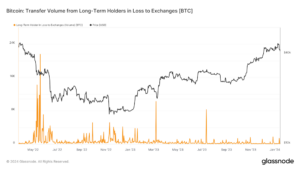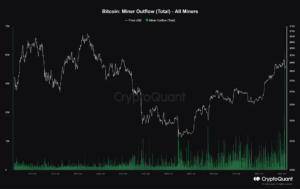The FTX collapse had previously led to consecutive drops of 10% and 14%. Sparking concerns about the potential for future market disruptions to trigger similar downturns.
Despite these substantial fluctuations, Bitcoin has exhibited resilience, recording a 1.15% increase in 2024. Within 72 hours of ETF trading, Bitcoin reached a yearly high of $49,100 and a low of $41,500. Furthermore, the Coinbase BTC/USD trading pair recorded its highest sales volume in the weekly time frame since the FTX crash in November 2022.
Panic Selling Nearly $5 Billion In A Day
The week meant for Bitcoin ETF activities was more about selling than buying Bitcoin for many investors. Despite the opportunity for institutions to increase their exposure to BTC, market dynamics reflected the psychological impact of volatility in a familiar manner.
Source: Glassnode
The bullish momentum faltered at the $50,000 mark, prompting whales to unload their holdings onto latecomers. So, the subsequent reversal towards $40,000 induced significant panic among market participants. This unease was evident in the proportion of BTC sold at a loss compared to the purchase price.
Also, on January 12, data from on-chain analytics firm Glassnode revealed that this reached 88,000 BTC (equivalent to $3.75 billion), with total sales amounting to 111,000 BTC (approximately $4.7 billion). Importantly, these sales predominantly originated from short-term holders (STHs) – entities holding a particular BTC investment for up to 155 days. The ETF announcement had prompted speculators to enter the market, anticipating further upward movement.
Source: Glassnode
In contrast, long-term holders (LTHs) showed minimal reaction to the events, keeping sales at a loss subdued, as indicated by Glassnode data.
BTC Miner Outflows Hit Six-Year Highs
Outflows from miners have surged to levels not seen in years, with tens of thousands of BTC, valued at over $1 billion, being transferred to exchanges. CryptoQuant data highlights that a significant portion of the Bitcoin movement originated from the mining company F2Pool.
Source: CryptoQuant
This trend is likely driven by the necessity to enhance liquidity in preparation for anticipated higher capital expenditures. Traditionally, many consider the movement of miners’ funds to exchanges a potentially bearish signal for Bitcoin’s price, as it frequently precedes downward price movements.
However, it’s important to note that this correlation is not always definitive, and outcomes can vary. For example, while previous instances of increased miner outflows sometimes coincided with price declines, there have also been occasions, such as in August 2019, when Bitcoin’s price continued to rise despite a surge in outflows.
BTC Long-Short Ratio Hits Multi-Month High
The long-short ratio for Bitcoin on Binance Futures has surged to its highest level in several months, indicating investor anticipation. This ratio is a gauge of market sentiment, with a higher long-short ratio indicating a positive outlook for Bitcoin’s price.
Over the last 24 hours, the long-short ratio has experienced a significant increase to 2.67, according to Coinglass data. This rise occurred despite Bitcoin retracing its gains following the approval of multiple spot bitcoin exchange-traded funds.
Source: Coinglass
The current reading is notably elevated, considering that a balanced number of traders on both sides would result in a ratio of 1. In the week preceding the approval of spot bitcoin ETFs, the long-short ratio was at a low of 0.86. However, post-approval, traders increased their positions, speculating on the asset’s potential appreciation.
A high long-short ratio reflects bullish sentiment in the market, while a low ratio indicates a bearish outlook. Presently, the prevailing sentiment for Bitcoin is predominantly bullish.
An extreme consensus or one-sided sentiment can sometimes serve as a contrarian indicator in financial markets. If most participants align their positions in one direction, such as being long, fewer participants may be left to drive higher prices further. This scenario could lead to a market correction or a period of consolidation.
More importantly, during times of crowded trading, characterized by a relatively high or low long-short ratio, there is a potential for a cascade of liquidations if the Bitcoin price experiences a sudden and significant swing in a particular direction.
What Now?
The $40,000 psychological level is a potential support for Bitcoin prices in the short term. However, we anticipate that Bitcoin’s price may find support even lower, potentially at $38,000. Nonetheless, a correction to at least $40,000 per bitcoin would fall within the scope of typical corrections, given the cryptocurrency’s remarkable price performance of over 150% throughout 2023.
Therefore, long-term expectations for Bitcoin remain predominantly bullish, fueled by evident demand for ETFs, particularly among institutional players, as reflected in trading volumes. The introduction of Bitcoin ETFs is poised to be transformative for the industry, enabling significantly broader access from traditional wealth management sectors. Many expect their launch to attract new investments into Bitcoin from various entities such as pensions, endowments, insurance companies, sovereign wealth funds, retirement plans, trusts, and more.
However, despite the excitement surrounding ETF launches, they offer little to no advantage over self-custody. For long-term holders, the associated fees could significantly erode a position. While it may take years, the demand for ETFs may decline as Bitcoin adoption increases, and self-custody will become more prevalent among institutions.
Besides, the upcoming bitcoin halving, which involves a reduction in the rate of new bitcoins issued to network validators (miners), is perceived by many as a potential catalyst for crypto prices. An ongoing debate exists about whether these programmatically triggered events, occurring every four years, are already “priced in.”
Conclusions
Anyhow, the approval of Bitcoin ETFs last week indicates what to expect in the next Bitcoin hype cycle. The listing of 11 new Bitcoin funds proved to be a clear selling point, at least in hindsight, as BTC subsequently experienced an approximately 11% decline to $42,850. Another significant development in the crypto sector this week is Coinbase’s appearance in federal court on Wednesday, seeking to dismiss the lawsuit brought against the company by the SEC last year.
The SEC accused Coinbase of allegedly offering and listing unregistered securities, among other charges. In any case, we expect a Bitcoin halving rally, followed by consolidation in the coming weeks. Moreover, BTC recovery from last week’s decline may extend beyond a month.
This environment could benefit Ethereum and other altcoins in the short term if Bitcoin’s dominance weakens.
Disclaimer
The information discussed by Altcoin Buzz is not financial advice. This is for educational, entertainment, and informational purposes only. Any information or strategies are thoughts and opinions relevant to the accepted levels of risk tolerance of the writer/reviewers and their risk tolerance may be different than yours. We are not responsible for any losses that you may incur as a result of any investments directly or indirectly related to the information provided. Bitcoin and other cryptocurrencies are high-risk investments so please do your due diligence. Copyright Altcoin Buzz Pte Ltd.

































